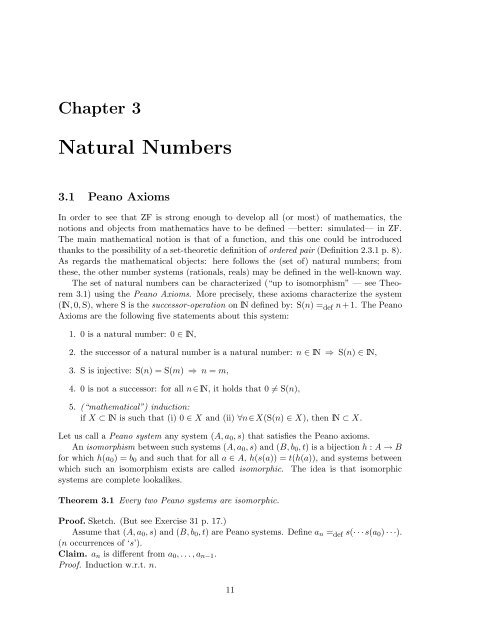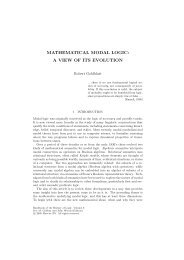Zermelo-Fraenkel Set Theory
Zermelo-Fraenkel Set Theory
Zermelo-Fraenkel Set Theory
Create successful ePaper yourself
Turn your PDF publications into a flip-book with our unique Google optimized e-Paper software.
Chapter 3<br />
Natural Numbers<br />
3.1 Peano Axioms<br />
In order to see that ZF is strong enough to develop all (or most) of mathematics, the<br />
notions and objects from mathematics have to be defined —better: simulated— in ZF.<br />
The main mathematical notion is that of a function, and this one could be introduced<br />
thanks to the possibility of a set-theoretic definition of ordered pair (Definition 2.3.1 p. 8).<br />
As regards the mathematical objects: here follows the (set of) natural numbers; from<br />
these, the other number systems (rationals, reals) may be defined in the well-known way.<br />
The set of natural numbers can be characterized (“up to isomorphism” — see Theorem<br />
3.1) using the Peano Axioms. More precisely, these axioms characterize the system<br />
(IN, 0, S), where S is the successor-operation on IN defined by: S(n) = def n + 1. The Peano<br />
Axioms are the following five statements about this system:<br />
1. 0 is a natural number: 0 ∈ IN,<br />
2. the successor of a natural number is a natural number: n ∈ IN ⇒ S(n) ∈ IN,<br />
3. S is injective: S(n) = S(m) ⇒ n = m,<br />
4. 0 is not a successor: for all n∈IN, it holds that 0 ≠ S(n),<br />
5. (“mathematical”) induction:<br />
if X ⊂ IN is such that (i) 0 ∈ X and (ii) ∀n∈X(S(n) ∈ X), then IN ⊂ X.<br />
Let us call a Peano system any system (A, a 0 , s) that satisfies the Peano axioms.<br />
An isomorphism between such systems (A, a 0 , s) and (B, b 0 , t) is a bijection h : A → B<br />
for which h(a 0 ) = b 0 and such that for all a ∈ A, h(s(a)) = t(h(a)), and systems between<br />
which such an isomorphism exists are called isomorphic. The idea is that isomorphic<br />
systems are complete lookalikes.<br />
Theorem 3.1 Every two Peano systems are isomorphic.<br />
Proof. Sketch. (But see Exercise 31 p. 17.)<br />
Assume that (A, a 0 , s) and (B, b 0 , t) are Peano systems. Define a n = def s(· · · s(a 0 ) · · ·).<br />
(n occurrences of ‘s’).<br />
Claim. a n is different from a 0 , . . . , a n−1 .<br />
Proof. Induction w.r.t. n.<br />
11

















